Key takeaways:
- Analyzing opponents in breakdancing goes beyond physical moves, incorporating emotional dynamics and body language.
- Adapting and responding strategically to an opponent’s strengths and weaknesses can create significant advantages in competitions.
- Understanding crowd energy and emotional shifts during battles can enhance performance and connection with the audience.
- Noticing the psychological aspect of dance battles is essential for evaluating both personal and opponent performance under pressure.
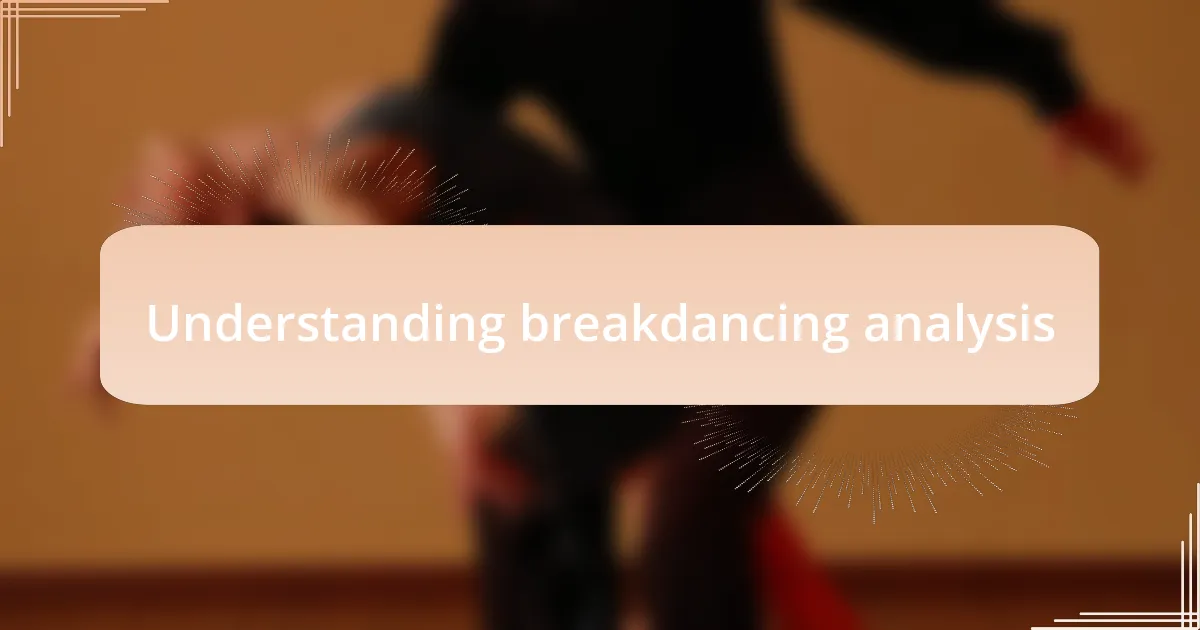
Understanding breakdancing analysis
Understanding breakdancing analysis is all about delving into the intricate layers of movement, style, and creativity that each dancer brings to the floor. When I first started analyzing opponents, I realized it wasn’t just about recognizing their skills but also understanding the emotions they convey through their movements. Have you ever watched a dancer and felt their energy resonate with you? That’s the power of a well-executed move.
As I observed various battles, I began to notice patterns in how certain dancers approached different styles. Some leaned heavily into technical precision, while others favored fluidity and artistry. This realization was eye-opening for me—it encouraged me to ask myself: what skills do I have that can outshine my opponent’s strengths? Analyzing my competitors not only helped me improve my own performance but also deepened my appreciation for the diversity in breakdancing styles.
In my experience, effective analysis involves not just watching battles but absorbing the atmosphere in the room. You can sense when a dancer is losing confidence or finding their groove. I vividly recall a moment when I faced a dancer whose energy electrified the crowd; I knew I had to adapt quickly. Understanding these dynamics is key in breakdancing, as it’s almost like a conversation happening in real time, and being attuned to the subtleties can make all the difference in a battle.
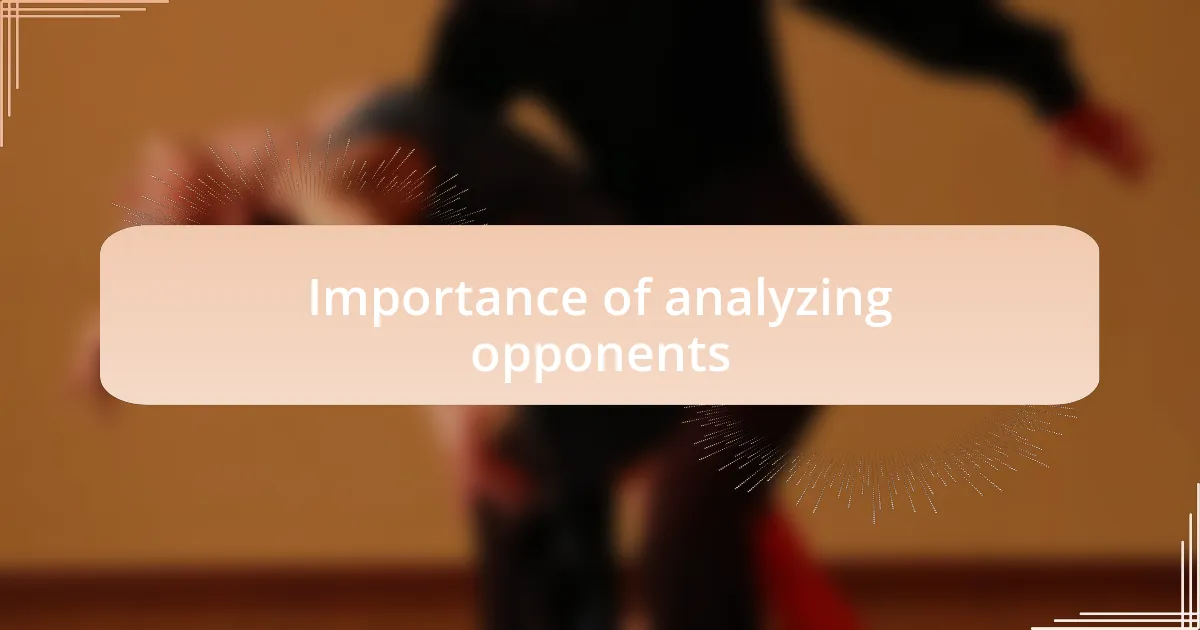
Importance of analyzing opponents
Analyzing opponents in breakdancing is crucial for strategic planning. I remember a showdown where my opponent had a unique style that I hadn’t encountered before. By studying their moves carefully before my turn, I was able to anticipate their next steps and counter them effectively, allowing me to gain the upper hand.
Understanding your opponent’s strengths and weaknesses helps you to refine your own skills. In one memorable battle, I noticed a competitor who could execute powerful freezes but had a tendency to rush transitions. This insight allowed me to capitalize on their vulnerabilities, creating space for my own more fluid style to shine, ultimately captivating the judges.
Moreover, the emotional landscape of a battle gives you a chance to connect your analysis to real-time decisions. I once faced a dancer who began strong but visibly fatigued midway. I felt that shift, which empowered me to ramp up my energy. Recognizing these emotional cues not only shapes your tactics but also helps you resonate more with the audience, making your performance all the more impactful.
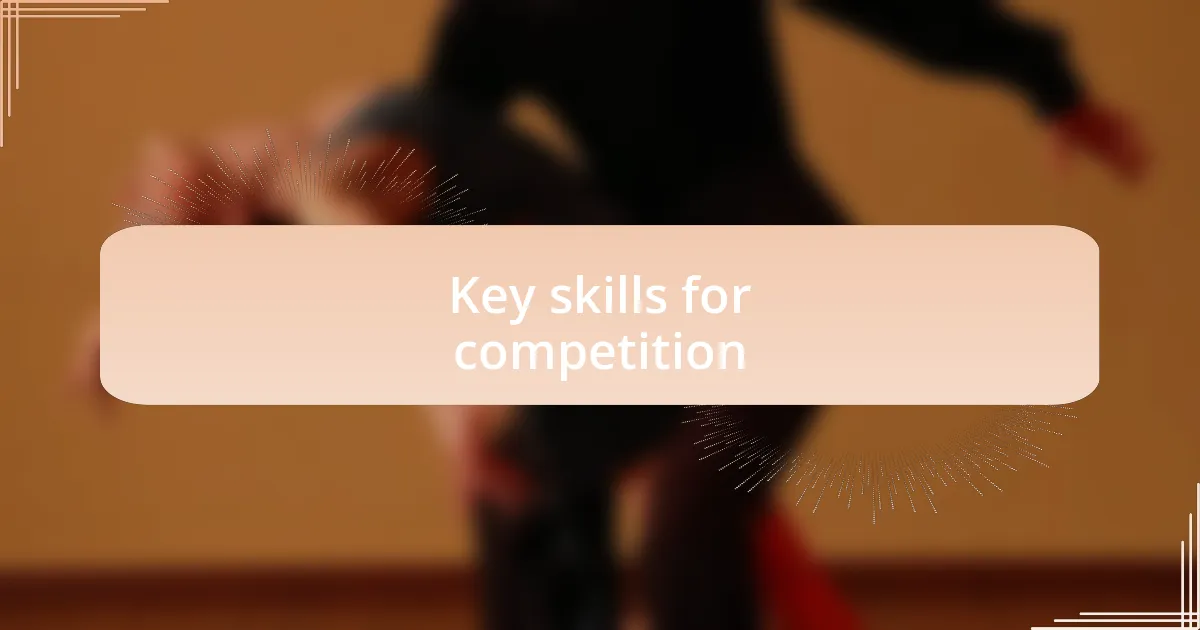
Key skills for competition
Key skills for competition
One essential skill in breakdancing competitions is adaptability. I recall a competition where the vibe shifted completely when the DJ played a track that many in the audience loved. Instead of sticking to my planned routine, I adjusted on the fly, using the energy from the crowd to elevate my performance. This flexibility not only impressed the judges but also created a deeper connection with the audience.
Another crucial skill is focus, especially when under pressure. In a particularly tense battle, I found myself facing an opponent known for their explosive power moves. As the crowd erupted with excitement, I concentrated on my breaths to maintain composure. I remember thinking, “How can I use my precision to outshine them?” That moment of clarity allowed me to execute my transitions with grace, turning what could have been a chaotic situation into an opportunity for a standout performance.
Lastly, building rapport can be a game-changer. During one competition, I noticed my rival struggling to connect with the audience. I decided to acknowledge their strength publicly, which changed the dynamic of our battle. Instead of focusing solely on the competition, we both elevated the atmosphere, and the positive vibes helped us engage more with the crowd. It’s a reminder that sometimes, competition isn’t just about the moves; it’s about the energy we create together.
Observing opponent’s techniques
When observing an opponent’s techniques, I focus on their signature moves and patterns. I once faced a dancer who had a distinct style, characterized by smooth freezes and intricate footwork. By closely watching how they executed these elements, I could anticipate their next move and plan my own strategies in response. Isn’t it fascinating how one unique technique can reshape the entire flow of a battle?
As I analyze my opponent’s strengths, I also look for potential weaknesses. During a recent showdown, I noticed that my rival overused a particular power move, which, while impressive, lacked variety. This insight allowed me to counter their routine with unexpected transitions that kept them off balance. Have you ever realized that sometimes familiarity can become a dancer’s biggest pitfall?
Beyond just the physical techniques, I pay attention to their body language and energy levels. I remember a time when I was up against someone who appeared confident but seemed to tire quickly. Their heavy breathing gave them away, and I capitalized on this by increasing my own energy to match their initial spark. It just goes to show that being attentive goes beyond the movements; it’s about understanding the whole performance.
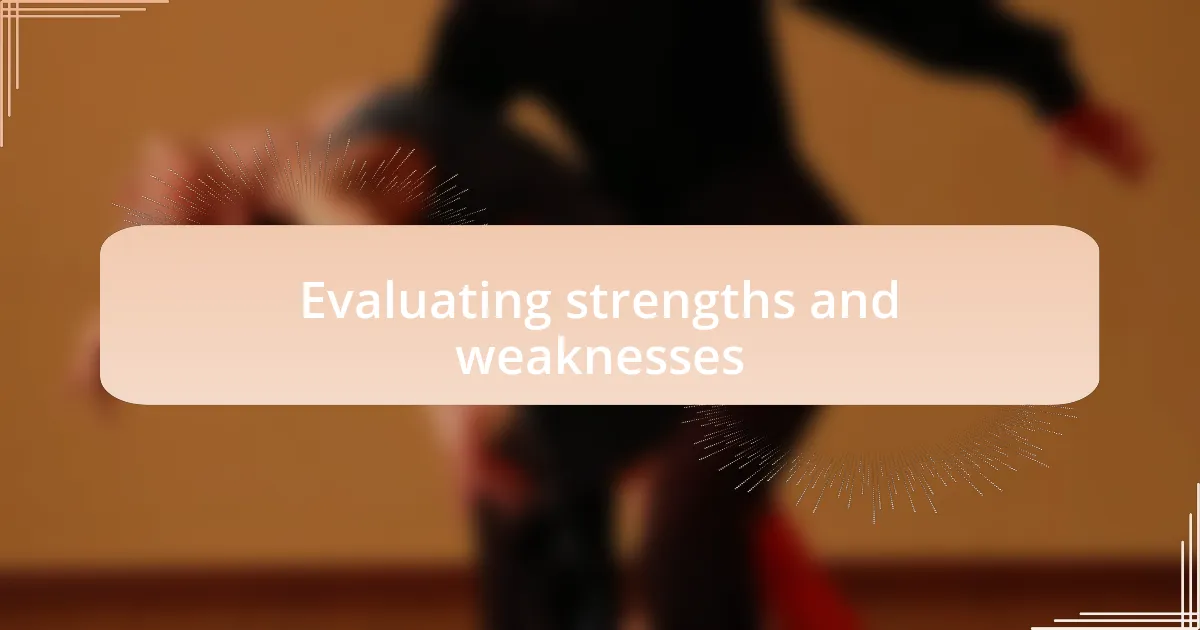
Evaluating strengths and weaknesses
To effectively evaluate strengths and weaknesses, I often rely on experience from previous battles. For example, during a competition, I faced a b-girl who possessed exceptional agility and speed. Observing her quick transitions, I realized this made her difficult to pin down. Yet, her rapid pace sometimes led to overcommitment, where a slight misstep could be turned against her. Have you ever encountered someone whose speed was their greatest asset but also their Achilles’ heel?
In my journey, I’ve learned that acknowledging weaknesses can be just as enlightening as recognizing strengths. I recall competing against a dancer who excelled at flashy moves but struggled with stamina as the battle wore on. I decided to dance at a measured pace that pushed our skills to their extremes. By extending my combos, I could see them falter as fatigue set in. It’s moments like these that emphasize how important it is to find a balance between flair and endurance, don’t you think?
I also find it helpful to assess how opponents handle pressure in a freestyle setting. During one memorable event, I observed a competitor who broke down under the weight of the crowd’s anticipation. While they started strong, their focus drifted, leading to a string of uncharacteristic mistakes. Watching them unravel made me think about my own mental preparation. How often do we overlook the psychological aspect of our performance?
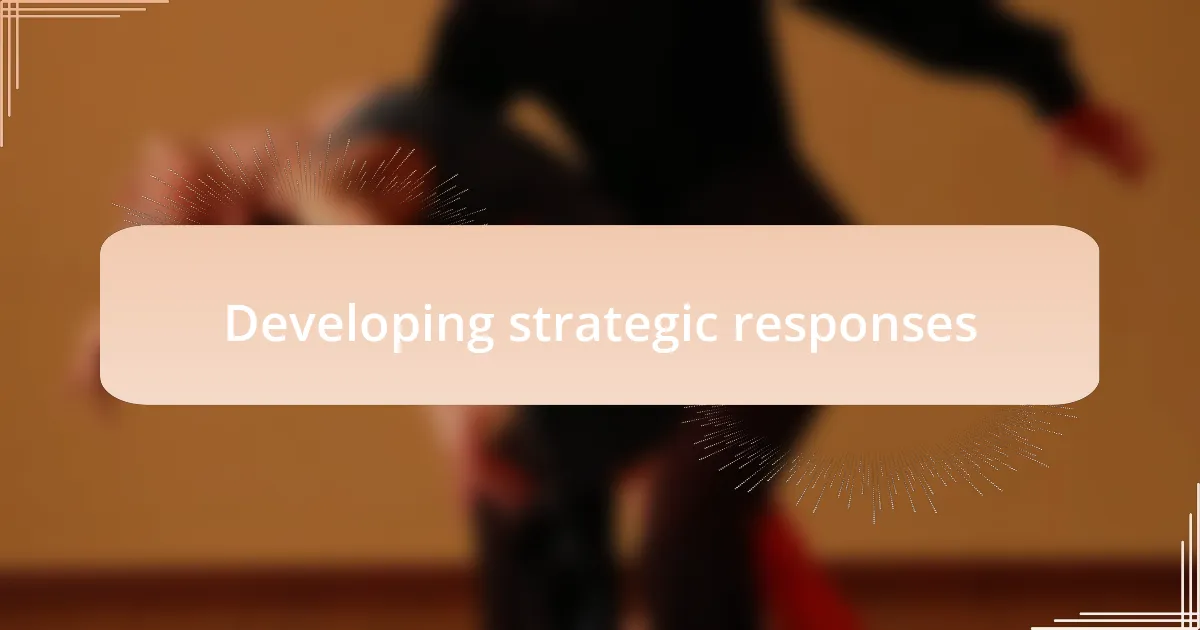
Developing strategic responses
Developing strategic responses requires me to think on my feet while staying attuned to my opponent’s patterns. I remember a battle where my opponent relied heavily on power moves to make an impression. I strategized by incorporating flowing transitions and intricate footwork to disrupt their rhythm. This forced them out of their comfort zone, transforming their explosiveness into a vulnerability. Have you ever noticed how a deviation from expected moves can unravel an opponent’s game plan?
In another instance, I faced a dancer whose style was a blend of technical precision and creativity, captivating the audience. I quickly realized that diverting their focus could be key. By throwing in unexpected elements, I not only kept them guessing but also created opportunities to capitalize on their reactionary dance. The thrill of seeing their confidence waver was exhilarating, and it reminded me of how crucial adaptability is in crafting our responses. How often do we prepare for all possibilities in dance battles?
On the emotional side, the moment I successfully distract my opponent, it sends an adrenaline rush through me, fueling my performance. It’s vital to tap into that energy, using it as a force to propel my own moves forward while keeping their uncertainty in the air. Understanding this dynamic allows me to transform any moment into an advantage. Connecting emotionally in battles can often set the stage for a remarkable comeback, don’t you think?
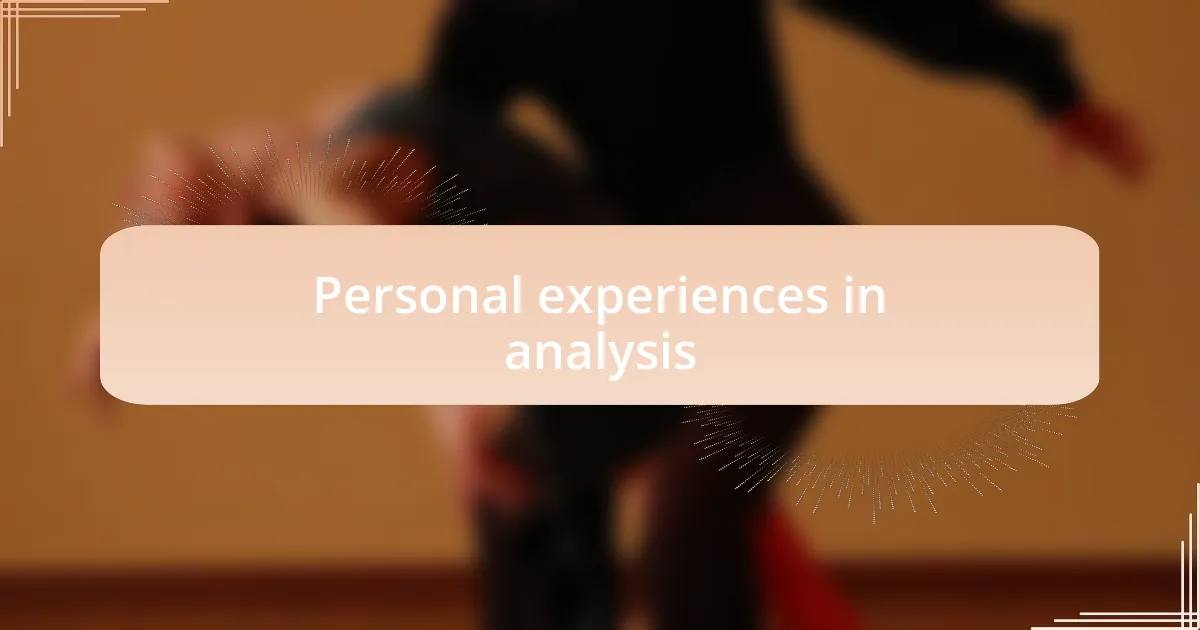
Personal experiences in analysis
When analyzing my opponents, I often reflect on a particular battle where I faced a dancer known for their intricate freezes. I vividly remember watching their movements closely, taking mental notes of how they transitions into each freeze. It hit me that their strength came from these moments of stillness. This realization empowered me to amplify my own fluidity, creating a dynamic contrast that captivated the judges.
In another instance, I encountered a rival who was exceptionally good at mixing styles—hip hop, ballet, and even some contemporary elements. During our battle, I decided to step outside my own style and deliberately over-emphasize my own community’s roots. This unexpected shift allowed me to assert my identity on stage while leading them into a less familiar territory. Have you ever had a moment where embracing your origins dramatically altered the battle’s outcome?
I often find that analyzing my opponents isn’t just about their physical moves but also their emotional cues. Once, I battled someone who seemed confident but had a tendency to rush their transitions when pressured. I made a conscious choice to push the tempo, watching how this affected their demeanor. The change in their energy was palpable, and I felt a rush of triumph. Doesn’t it make you wonder how much our understanding of emotions can play into the dance?